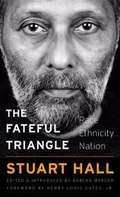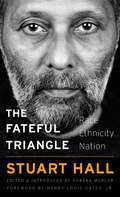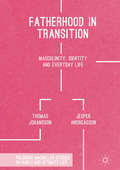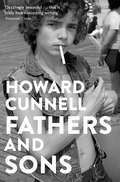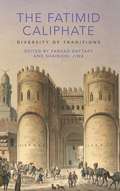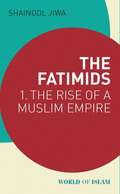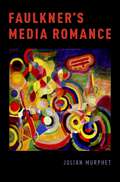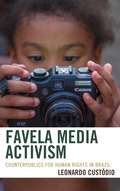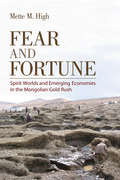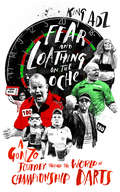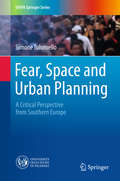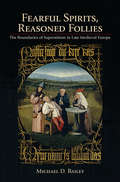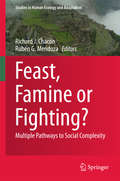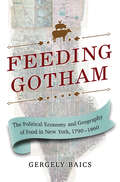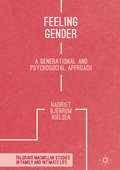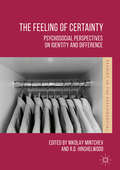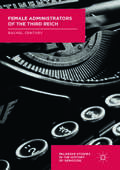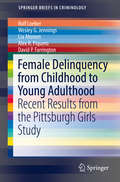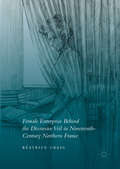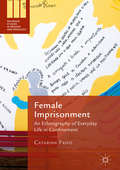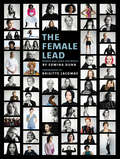- Table View
- List View
The Fateful Triangle: Race, Ethnicity, Nation (The\w. E. B. Du Bois Lectures #19)
by Stuart HallIn this work drawn from lectures delivered in 1994 a founding figure of cultural studies reflects on the divisive, deadly consequences of our politics of identification. Stuart Hall untangles the power relations that permeate race, ethnicity, and nationhood and shows how oppressed groups broke apart old hierarchies of difference in Western culture.
The Fateful Triangle: Race, Ethnicity, Nation (The\w. E. B. Du Bois Lectures #19)
by Stuart HallIn this work drawn from lectures delivered in 1994 a founding figure of cultural studies reflects on the divisive, deadly consequences of our politics of identification. Stuart Hall untangles the power relations that permeate race, ethnicity, and nationhood and shows how oppressed groups broke apart old hierarchies of difference in Western culture.
Fatherhood in Transition: Masculinity, Identity and Everyday Life (Palgrave Macmillan Studies in Family and Intimate Life)
by Thomas Johansson Jesper AndreassonThis book discusses and analyses the ways in which fatherhood is in transition in contemporary and globalized society. The authors identify and examine fathering practices in relation to hegemonic and marginal patterns of masculinity, the concept of heteronormativity and sexuality, and patterns of segregation, class and national differences. Contextualised in relation to theories of fatherhood and relevant statistics, Fatherhood in Transition presents rich empirical material gathered in a number of western countries. It focuses on key themes including transnational fathering and families, gay fathers and the virtual global arena of fatherhood images found on the internet. Containing a number of new discussions about masculinity and fatherhood, whilst contributing to and developing existing debates and theories about men, masculinity, gender and society, this book will be of interest to students and scholars across a range of disciplines, including Men’s Studies, Gender Studies, Sociology, Psychology, Media Studies and Cultural Studies.
Fathers and Sons
by Howard Cunnell‘There is so much aching love in this book, such pain and beauty. Behold, and rejoice.’ – Tim Winton, author of CloudstreetWas he thinking, do I have to be this kind of boy to survive? Is this what being a boy is?As a boy growing up on the south coast of England, Howard Cunnell’s sense of self was dominated by his father’s absence. Now, years later, he is a father, and his daughter is becoming his son.Starting with his own childhood in the Sussex beachlands, Howard tells the story of the years of self-destruction that defined his young adulthood and the escape he found in reading and the natural world. Still he felt compelled to destroy the relationships that mattered to him.Saved by love and responsibility, Cunnell charts his journey from anger to compassion, as his daughter Jay realizes he is a boy, and a son.Most of all, this is a story about love – its necessity and fragility, and its unequalled capacity to enable us to be who we are.Deeply thoughtful, searingly honest and exquisitely lyrical, Fathers and Sons is an exploration of fatherhood, masculinity, authenticity and family.
The Fatimid Caliphate: Diversity of Traditions (Ismaili Heritage #20161030)
by Farhad Daftary Shainool JiwaThe Fatimids ruled much of the Mediterranean world for over two centuries. From the conquest of Ifriqiya in 909 to defeat at the hands of Saladin in 1171, the Fatimid caliphate governed a broad area stretching, at its peak, from the Red Sea in the East to the Atlantic Ocean in the West. Their leaders - the Ismaili Shi?i Imam-caliphs - were notable for largely pursuing a policy of tolerance towards the various religious and ethnic communities of their realm, and they embraced diverse approaches to administering a vast empire. Such methods of negotiating government an diversity created a lasting pluralistic legacy. The present volume, edited by Farhad Daftary and Shainool Jiwa, brings together original contributions from a number of leading authorities in the field. Based on analyses of primary sources,the chapters shed fresh light on the impact of Fatimid rule. The book presents little-explored aspects of state-society relations such as the Fatimid model of the vizierate, Sunni legal responses to Fatimid traditions, and the role of women in prayer. Highlighting the distinctive nature of the Fatimid empire and its legacy, this book will be of special interest to researchers in medieval Islamic history and thought.
The Fatimids: 1 - The Rise of a Muslim Empire (World of Islam)
by Shainool JiwaEmerging from a period of long seclusion, in the year 909 the leader of the burgeoning community of Ismaili Shi'i Muslims was declared the first Fatimid Imam-caliph. Abd Allah al-Mahdi founded the only sustained Shi'i dynasty (909–1171) to rule over substantial parts of the medieval Muslim world, rivalling both the Umayyads of Spain and the Abbasids. At its peak, the Fatimid Empire extended from the Atlantic shores of North Africa, across the southern Mediterranean and down both sides of the Red Sea, covering also Mecca and Medina. This accessible history, the first of two volumes, tells the story of the birth and expansion of the Fatimid Empire in the tenth century. Drawing upon recently available eyewitness accounts, Shainool Jiwa introduces the first four generations of Fatimid Imam-caliphs - al-Mahdi, al-Qa'im, al-Mansur and al-Mu'izz - as well as the people who served them and those they struggled against. Readers are taken on a journey through the Fatimid capitals of Qayrawan, Mahdiyya and Mansuriyya and on to the founding of Cairo. In this lively and comprehensive introduction, we discover various milestones in Fatimid history and the political and cultural achievements that continue to resonate today.
Faulkner's Media Romance
by Julian MurphetThis book treats William Faulkner's major fiction--from Flags in the Dust through to Absalom, Absalom!--to a searching reappraisal under the spotlight of a media-historical inquiry. It proposes that Faulkner's inveterate attraction to the paradigms of romance was disciplined and masked by the recurrent use of metaphorical figures borrowed from the new media ecology. Faulkner dressed up his romance materials in the technological garb of radio, gramophony, photography, and cinema, along with the transportational networks of road and air that were being installed in the 1920s. His modernism emerges from a fraght but productive interplay between his anachronistic predilection for chivalric chichés and his extraordinarily knowledgeable interest in the most up-to-date media institutions and forms. Rather than see Faulkner as a divided author, who worked for money in the magazines and studios while producing his serious fiction in despite of their symbolic economies, this study demonstrates how profoundly his mature art was shot through with the figures and dynamics of the materials he publicly repudiated. The result is a richer and more nuanced understanding of the dialectics of his art.
Favela Media Activism: Counterpublics for Human Rights in Brazil (PDF)
by Leonardo CustódioWhat explains the engagement of low-income young people in media initiatives for political mobilization and social change in everyday life? Favela Media Activism: Counterpublics for Human Rights in Brazil responds to this question using an in-depth ethnographic and interdisciplinary study about the trajectories in media activism among young residents of low-income and violence-ridden favelas in socially unequal Rio de Janeiro. Leonardo Custodio provides multifaceted analyses of how favela youth engage in individual and collective media activist initiatives despite social class constraints and neoliberal imperatives in their everyday life. This book details processes experienced by young favela residents while becoming individuals who act to challenge and change patterns of discrimination, governmental neglect and drug-related violence. It is an important resource for scholars interested in the nuances of political engagement among marginalized youth in today's world of hyper-connectivity, information abundance, and the persistence of racial and social inequalities.
Fear and Fortune: Spirit Worlds and Emerging Economies in the Mongolian Gold Rush
by Mette M. HighMongolia over the last decade has seen a substantial and ongoing gold rush. The widespread mining of gold looks at first glance to be a blessing for a desperately poor and largely pastoralist country where people's lives were disrupted by the end of the USSR and tens of millions of livestock were killed in devastating droughts in the early 2000s. Volatility and uncertainty as well as political and economic turmoil led many people to join the hopeful search for gold. This activity, born out of uncertain times, poses an intense moral problem; in the "land of dust," disturbing the ground and extracting the precious metal is widely believed to have calamitous consequences. With gold retaining strong ties to the landscape and its many spirit beings, the fortune of the precious metal is inseparable from the fears that surround mining. Tracing the continuities and discontinuities between human and nonhuman worlds, Mette M. High follows the paths of gold as it is excavated and converted into "polluted money," entering local shops and Buddhist monasteries, joining the illegal gold trade, and returning as "renewed" money for the "big bosses" of the gold mines.High has done several years of fieldwork in Mongolia, spending time with the "ninjas," as the miners are known locally, as well as the people who disapprove of their illegal activities and warn of the retribution that the land and its inhabitants may suffer as a result. This book is about radical change, or as many Mongolians put it, when life becomes "strange" and "chaotic." High has gained a deep understanding of the processes by which Mongolians square a morally questionable activity with the lure of profit. How do they involve themselves with tainted sources of money, and can it ever be cleansed and made usable? Addressing how our lives and those of others are intimately intertwined, Fear and Fortune offers an expansive and capacious approach to understanding the high stakes involved in human economic life.
Fear and Loathing on the Oche: A Gonzo Journey Through the World of Championship Darts
by King AdzAnyone who’s ever seen or attended the PDC World Darts Championships knows that darts is no ordinary sport. Where else would you find world-class superstars, in the midst of a championship match, cultivating tomorrow’s banging hangover? Or two separate organisations, with a bitter historical rivalry, taking potshots at each other in a bid to secure players, fans and an all-important TV broadcast contract?And then there’s the fans… Darts fans are unlike any other fans in world sport. They drink the most, they wear the silliest costumes, they sing the loudest and yet they can arguably see the least live action. They feel an immense pride and ownership for the game – its theirs, and they couldn’t care less about the sneers from the mainstream. Join King ADZ as he dives headfirst into this tempestuous world, meeting former legends, future stars, dominant Internationals, the owners, the referees and of course the fans. Darts may be a simple game to many, but to most it’s absolute mayhem.
Fear, Space and Urban Planning: A Critical Perspective from Southern Europe (UNIPA Springer Series)
by Simone TulumelloThis book examines the phenomenon of urban fear – the increasing anxiety over crime and violence in Western cities despite their high safety – with a view to developing a comprehensive, critical, exploratory theory of fear, space, and urban planning that unravels the paradoxes of their mutual relations. By focusing especially on the southern European cities of Palermo and Lisbon, the book also aims to expand upon recent studies on urban geopolitics, enriching them from the perspective of ordinary, as opposed to global, cities. Readers will find enlightening analysis of the ways in which urban fear is (re)produced, including by misinformative discourses on security and fear and the political construction of otherness as a means of exclusion. The spatialization of fear, e.g., through fortification, privatization, and fragmentation, is explored, and the ways in which urban planning is informed by and has in turn been shaping urban fear are investigated. A concluding chapter considers divergent potential futures and makes a call for action. The book will appeal to all with an interest in whether, and to what extent, the production of ‘fearscapes’, the contemporary landscapes of fear, constitutes an emergent urban political economy.
Fearful Spirits, Reasoned Follies: The Boundaries of Superstition in Late Medieval Europe
by Michael D. BaileySuperstitions are commonplace in the modern world. Mostly, however, they evoke innocuous images of people reading their horoscopes or avoiding black cats. Certain religious practices might also come to mind—praying to St. Christopher or lighting candles for the dead. Benign as they might seem today, such practices were not always perceived that way. In medieval Europe superstitions were considered serious offenses, violations of essential precepts of Christian doctrine or immutable natural laws. But how and why did this come to be? In Fearful Spirits, Reasoned Follies, Michael D. Bailey explores the thorny concept of superstition as it was understood and debated in the Middle Ages. Bailey begins by tracing Christian thinking about superstition from the patristic period through the early and high Middle Ages. He then turns to the later Middle Ages, a period that witnessed an outpouring of writings devoted to superstition—tracts and treatises with titles such as De superstitionibus and Contra vitia superstitionum. Most were written by theologians and other academics based in Europe’s universities and courts, men who were increasingly anxious about the proliferation of suspect beliefs and practices, from elite ritual magic to common healing charms, from astrological divination to the observance of signs and omens. As Bailey shows, however, authorities were far more sophisticated in their reasoning than one might suspect, using accusations of superstition in a calculated way to control the boundaries of legitimate religion and acceptable science. This in turn would lay the conceptual groundwork for future discussions of religion, science, and magic in the early modern world. Indeed, by revealing the extent to which early modern thinkers took up old questions about the operation of natural properties and forces using the vocabulary of science rather than of belief, Bailey exposes the powerful but in many ways false dichotomy between the "superstitious" Middle Ages and "rational" European modernity.
Feast, Famine or Fighting?: Multiple Pathways to Social Complexity (Studies in Human Ecology and Adaptation #8)
by Richard J. Chacon Rubén G. MendozaThe advent of social complexity has been a longstanding debate among social scientists. Existing theories and approaches involving the origins of social complexity include environmental circumscription, population growth, technology transfers, prestige-based and interpersonal-group competition, organized conflict, perennial wartime leadership, wealth finance, opportunistic leadership, climatological change, transport and trade monopolies, resource circumscription, surplus and redistribution, ideological imperialism, and the consideration of individual agency.However, recent approaches such as the inclusion of bioarchaeological perspectives, prospection methods, systematically-investigated archaeological sites along with emerging technologies are necessarily transforming our understanding of socio-cultural evolutionary processes. In short, many pre-existing ways of explaining the origins and development of social complexity are being reassessed. Ultimately, the contributors to this edited volume challenge the status quo regarding how and why social complexity arose by providing revolutionary new understandings of social inequality and socio-political evolution.
Feeding Gotham: The Political Economy and Geography of Food in New York, 1790–1860
by Gergely BaicsNew York City witnessed unparalleled growth in the first half of the nineteenth century, its population rising from thirty thousand people to nearly a million in a matter of decades. Feeding Gotham looks at how America's first metropolis grappled with the challenge of provisioning its inhabitants. It tells the story of how access to food, once a public good, became a private matter left to free and unregulated markets—and of the profound consequences this had for American living standards and urban development.Taking readers from the early republic to the Civil War, Gergely Baics explores the changing dynamics of urban governance, market forces, and the built environment that defined New Yorkers’ experiences of supplying their households. He paints a vibrant portrait of the public debates that propelled New York from a tightly regulated public market to a free-market system of provisioning, and shows how deregulation had its social costs and benefits. Baics uses cutting-edge GIS mapping techniques to reconstruct New York’s changing food landscapes over half a century, following residents into neighborhood public markets, meat shops, and groceries across the city’s expanding territory. He lays bare how unequal access to adequate and healthy food supplies led to an increasingly differentiated urban environment.A masterful blend of economic, social, and geographic history, Feeding Gotham traces how this highly fragmented geography of food access became a defining and enduring feature of the American city.
Feeding Gotham: The Political Economy and Geography of Food in New York, 1790–1860
by Gergely BaicsNew York City witnessed unparalleled growth in the first half of the nineteenth century, its population rising from thirty thousand people to nearly a million in a matter of decades. Feeding Gotham looks at how America's first metropolis grappled with the challenge of provisioning its inhabitants. It tells the story of how access to food, once a public good, became a private matter left to free and unregulated markets—and of the profound consequences this had for American living standards and urban development.Taking readers from the early republic to the Civil War, Gergely Baics explores the changing dynamics of urban governance, market forces, and the built environment that defined New Yorkers’ experiences of supplying their households. He paints a vibrant portrait of the public debates that propelled New York from a tightly regulated public market to a free-market system of provisioning, and shows how deregulation had its social costs and benefits. Baics uses cutting-edge GIS mapping techniques to reconstruct New York’s changing food landscapes over half a century, following residents into neighborhood public markets, meat shops, and groceries across the city’s expanding territory. He lays bare how unequal access to adequate and healthy food supplies led to an increasingly differentiated urban environment.A masterful blend of economic, social, and geographic history, Feeding Gotham traces how this highly fragmented geography of food access became a defining and enduring feature of the American city.
Feeding Japan: The Cultural and Political Issues of Dependency and Risk
by Andreas Niehaus and Tine WalravensThis edited collection explores the historical dimensions, cultural practices, socio-economic mechanisms and political agendas that shape the notion of a national cuisine inside and outside of Japan. Japanese food is often perceived as pure, natural, healthy and timeless, and these words not only fuel a hype surrounding Japanese food and lifestyle worldwide, but also a domestic retro-movement that finds health and authenticity in ‘traditional’ ingredients, dishes and foodways. The authors in this volume bring together research from the fields of history, cultural and religious studies, food studies as well as political science and international relations, and aim to shed light on relevant aspects of culinary nationalism in Japan while unearthing the underlying patterns and processes in the construction of food identities.
Feeling Gender: A Generational and Psychosocial Approach (Palgrave Macmillan Studies in Family and Intimate Life)
by Harriet Bjerrum NielsenThis book is open access under a CC BY 4.0 license.This book explores how feelings about gender have changed over three interrelated generations of women and men of different social classes during the twentieth century. The author explores the ways in which generational experiences are connected, what is continued, what triggers gradual or abrupt changes between generations - and between women and men within these generations. The book explores how new feelings of gender gradually change gender norms from within, and how they contribute to the incremental creation of new social practices. Nielsen suggests a new way of conducting psychosocial research that focuses on generational psychological patterns of gender identities and gendered subjectivities in times of change from a psychoanalytic perspective. Combining generational and longitudinal research, the book works with temporality as a theoretical as well as a methodological dimension. Theoretically it combines Raymond Williams' idea of "a structure of feeling" with the work of Eric Fromm, Hans Loewald, Nancy Chodorow and Jessica Benjamin.
The Feeling of Certainty: Psychosocial Perspectives on Identity and Difference
by Nikolay Mintchev R. D. HinshelwoodThis book explores the concept of certainty, a term which is widely used in everyday language to designate a psychological experience or feeling but is rarely considered controversial or politically charged. The Feeling of Certainty argues that conversely this most ordinary of feelings plays a key role in shaping identity formation, social exclusion, prejudice, and commitment to political causes. The authors question what it means for the subject to feel certainty about her or his relationships to self and others. From where does the feeling of certainty originate, and how does it differ from modes of thought that are open to scepticism about the order of things? They draw on a wide range of theories, including those of Freud, Klein, Lacan, Wittgenstein, Bion, and Jung, challenging readers to consider the world of ideologies, symbols, and stereotypes in which certainty is entrenched, as well as the inter- and intra-psychic processes and defence mechanisms which form the unconscious foundation of the experience of certainty. This collection will offer valuable insight to scholars of psychology, politics, social science and history.
The Feeling of Certainty: Psychosocial Perspectives on Identity and Difference
by Nikolay Mintchev R. D. HinshelwoodThis book explores the concept of certainty, a term which is widely used in everyday language to designate a psychological experience or feeling but is rarely considered controversial or politically charged. The Feeling of Certainty argues that conversely this most ordinary of feelings plays a key role in shaping identity formation, social exclusion, prejudice, and commitment to political causes. The authors question what it means for the subject to feel certainty about her or his relationships to self and others. From where does the feeling of certainty originate, and how does it differ from modes of thought that are open to scepticism about the order of things? They draw on a wide range of theories, including those of Freud, Klein, Lacan, Wittgenstein, Bion, and Jung, challenging readers to consider the world of ideologies, symbols, and stereotypes in which certainty is entrenched, as well as the inter- and intra-psychic processes and defence mechanisms which form the unconscious foundation of the experience of certainty. This collection will offer valuable insight to scholars of psychology, politics, social science and history.
Female Administrators of the Third Reich (Palgrave Studies in the History of Genocide)
by Rachel CenturyThis book compares female administrators who specifically chose to serve the Nazi cause in voluntary roles with those who took on such work as a progression of established careers. Under the Nazi regime, secretaries, SS-Helferinnen (female auxiliaries for the SS) and Nachrichtenhelferinnen des Heeres (female auxiliaries for the army) held similar jobs: taking dictation, answering telephones, sending telegrams. Yet their backgrounds and degree of commitment to Nazi ideology differed markedly. The author explores their motivations and what they knew about the true nature of their work. These women had access to information about the administration of the Holocaust and are a relatively untapped resource. Their recollections shed light on the lives, love lives, and work of their superiors, and the tasks that contributed to the displacement, deportation and death of millions. The question of how gender intersected with Nazism, repression, atrocity and genocide forms the conceptual thread of this book.
Female Delinquency From Childhood To Young Adulthood: Recent Results from the Pittsburgh Girls Study (SpringerBriefs in Criminology)
by Rolf Loeber Wesley G. Jennings Lia Ahonen Alex R. Piquero David P. FarringtonThis Brief fills a gap in criminological literature, as there are few empirically-based studies on delinquency of adolescent girls. It provides results of a longitudinal study, The Pittsburgh Girls Study (PGS), which includes 2,451 girls, followed annually from age 10-19, the ages when criminal behavior tends to emerge. This study provides the most extensive and comprehensive investigation into the criminal offending and self-reported trajectories of offending of PGS participants, along with an in-depth examination of other criminal career dimensions.In five chapters, this short volume reviews the limited extent of girls' delinquency literature, presents data on girls' offending patterns (onset, persistence, specialization, and desistence), provides insights on gender differences by comparison with the Pittsburgh Youth Study, which focused on male offenders, and explores the theoretical and practical implications of the results.By understanding the origins and onset of criminal behavior in girls, researchers can begin to understand effective interventions and crime prevention. This Brief will be of interest to researchers in criminology and criminal justice, as well as related fields such as sociology, public policy, and psychology.
Female Enterprise Behind the Discursive Veil in Nineteenth-Century Northern France
by Béatrice CraigThis volume explores the role of women in business in nineteenth-century Northern French textile centers. Lille and the surrounding towns were then dominated by big and small family businesses, and many were run by women. Those women did not withdraw into the parlour as the century progressed and the ‘separate ideology’ spread. Neither did they become mere figure heads - most were business persons in their own rights. Yet, they have left almost no traces in the collective memory, and historians assume they ceased to exist. This book therefore seeks to answer three interrelated questions: How common were those women, and what kind of business did they run? What factors facilitated or impeded their activities? And finally, why have they been forgotten, and why has their representations in regional and academic history been so at odd with reality? Indirectly, this study also sheds light on the process of industrialization in this region, and on industrialists’ strategies.
Female Imprisonment: An Ethnography of Everyday Life in Confinement
by Catarina FroisThis book is a reflection on the nature of confinement, experienced by prison inmates as everyday life. It explores the meanings, purposes, and consequences involved with spending every day inside prison. Female Imprisonment results from an ethnographic study carried out in a small prison facility located in the south of Portugal, and Frois uses the data to analyze how incarcerated women talk about their lives, crimes, and expectations. Crucially, this work examines how these women consider prison: rather than primarily being a place of confinement designed to inflict punishment, it can equally be a place of transformation that enables them to regain a sense of selfhood. From in-depth ethnographic research involving close interaction with the prison population, in which inmates present their life histories marked by poverty, violence, and abuse (whether as victims, as agents, or both), Frois observes that the traditional idea of “doing time”, in the sense of a strenuous, repressive, or restrictive experience, is paradoxically transformed into “having time” – an experience of expanded self-awareness, identity reconstruction, or even of deliverance. Ultimately, this engaging and compassionate study questions and defies customary accounts of the impact of prisons on those subjected to incarceration, and as such it will be of great interest for scholars and students of penology and the criminal justice system.
Female Imprisonment: An Ethnography of Everyday Life in Confinement
by Catarina FroisThis book is a reflection on the nature of confinement, experienced by prison inmates as everyday life. It explores the meanings, purposes, and consequences involved with spending every day inside prison. Female Imprisonment results from an ethnographic study carried out in a small prison facility located in the south of Portugal, and Frois uses the data to analyze how incarcerated women talk about their lives, crimes, and expectations. Crucially, this work examines how these women consider prison: rather than primarily being a place of confinement designed to inflict punishment, it can equally be a place of transformation that enables them to regain a sense of selfhood. From in-depth ethnographic research involving close interaction with the prison population, in which inmates present their life histories marked by poverty, violence, and abuse (whether as victims, as agents, or both), Frois observes that the traditional idea of “doing time”, in the sense of a strenuous, repressive, or restrictive experience, is paradoxically transformed into “having time” – an experience of expanded self-awareness, identity reconstruction, or even of deliverance. Ultimately, this engaging and compassionate study questions and defies customary accounts of the impact of prisons on those subjected to incarceration, and as such it will be of great interest for scholars and students of penology and the criminal justice system.
The Female Lead: Women Who Shape Our World
by Edwina Dunn Brigitte LacombeSixty inspirational women, from many walks of life. All have changed the world in a variety of fields. Among them are politicians and artists, journalists and teachers, engineers and campaigners, fire fighters and film stars. Together they form an arresting gallery of portraits, each one illustrated with original photography by Brigitte Lacombe.Some have led their professions; some have broken new ground for women; some have inspired changes through relentless endeavour. All were chosen for their ambitions and achievements and all tell their stories in their own words.For girls, it can be hard to identify role models in our society. This book will help and inspire women everywhere to realize their hopes and ambitions.
